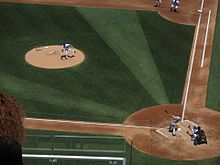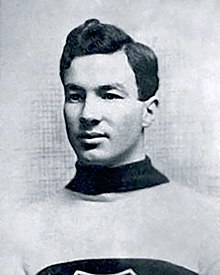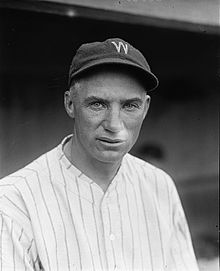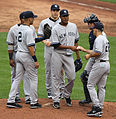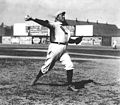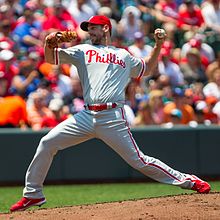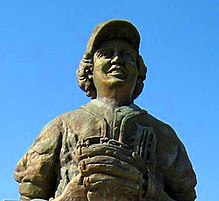Portal:Baseball
Portal maintenance status: (June 2018)
|
| Main page | Content, Categories & Topics | WikiProjects & Things you can do |
The Baseball Portal
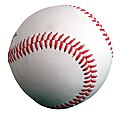
Baseball is a bat-and-ball sport played between two teams of nine players each, taking turns batting and fielding. The game occurs over the course of several plays, with each play generally beginning when a player on the fielding team, called the pitcher, throws a ball that a player on the batting team, called the batter, tries to hit with a bat. The objective of the offensive team (batting team) is to hit the ball into the field of play, away from the other team's players, allowing its players to run the bases, having them advance counter-clockwise around four bases to score what are called "runs". The objective of the defensive team (referred to as the fielding team) is to prevent batters from becoming runners, and to prevent runners advancing around the bases. A run is scored when a runner legally advances around the bases in order and touches home plate (the place where the player started as a batter).
The opposing teams switch back and forth between batting and fielding; the batting team's turn to bat is over once the fielding team records three outs. One turn batting for each team constitutes an inning. A game is usually composed of nine innings, and the team with the greater number of runs at the end of the game wins. Most games end after the ninth inning, but if scores are tied at that point, extra innings are usually played. Baseball has no game clock, though some competitions feature pace-of-play regulations such as the pitch clock to shorten game time.
Baseball evolved from older bat-and-ball games already being played in England by the mid-18th century. This game was brought by immigrants to North America, where the modern version developed. Baseball's American origins, as well as its reputation as a source of escapism during troubled points in American history such as the American Civil War and the Great Depression, have led the sport to receive the moniker of "America's Pastime"; since the late 19th century, it has been unofficially recognized as the national sport of the United States, though in modern times is considered less popular than other sports, such as American football. In addition to North America, baseball spread throughout the rest of the Americas and the Asia–Pacific in the 19th and 20th centuries, and is now considered the most popular sport in parts of Central and South America, the Caribbean, and East Asia, particularly in Japan, South Korea, and Taiwan. (Full article...)
 Featured articles - load new batch
Featured articles - load new batch
-
Image 1Adenhart pitching for the Salt Lake Bees in 2008
Nicholas James Adenhart (August 24, 1986 – April 9, 2009) was an American right-handed baseball starting pitcher who played parts of two seasons in Major League Baseball (MLB) for the Los Angeles Angels of Anaheim. In just four career games, Adenhart pitched 18 innings and posted a win-loss record of 1–0.
A graduate of Williamsport High School, Adenhart was highly touted as a high school prospect until an injury in his final game required Tommy John surgery. The Angels drafted him in the 14th round of the 2004 Major League Baseball draft, and began playing in their minor league system after the surgery was a success. He spent three full seasons in the minor leagues before making his major league debut on May 1, 2008. After appearing in three games, Adenhart spent the rest of 2008 in the minor leagues developing his skills, and in 2009 he earned a spot in the Angels' starting rotation. (Full article...) -
Image 2

WSNS-TV (channel 44) is a television station in Chicago, Illinois, United States, serving as the local outlet for the Spanish-language network Telemundo. It is owned and operated by NBCUniversal's Telemundo Station Group alongside NBC outlet WMAQ-TV (channel 5). The two stations share studios at the NBC Tower on North Columbus Drive in the city's Streeterville neighborhood and broadcast from the same transmitter atop the Willis Tower in the Chicago Loop.
WSNS-TV began broadcasting in 1970. Originally specializing in the automated display of news headlines, it evolved into Chicago's third full-fledged independent station, carrying movies, local sports, and other specialty programming. This continued until 1980, when WSNS became the Chicago-area station for ON TV, an over-the-air subscription television (STV) service owned by Oak Industries, which took a minority ownership stake in the station. While ON TV was successful in Chicago and the subscription system became the second-largest in the country by total subscribers, the rise of cable television precipitated the end of the business in 1985, with WSNS-TV as the last ON TV station standing. (Full article...) -
Image 3Ross with the Montreal Wanderers, circa 1907–18
Arthur Howey Ross (January 13, 1885 – August 5, 1964) was a Canadian professional ice hockey player and executive from 1905 until 1954. Regarded as one of the best defenders of his era by his peers, he was one of the first to skate with the puck up the ice rather than pass it to a forward. He was on Stanley Cup championship teams twice in a playing career that lasted thirteen seasons; in January 1907 with the Kenora Thistles and 1908 with the Montreal Wanderers. Like other players of the time, Ross played for several different teams and leagues, and is noted for his time with the Wanderers while they were members of the National Hockey Association (NHA) and its successor, the National Hockey League (NHL). In 1911, he led one of the first organized player strikes over increased pay. When the Wanderers' home arena burned down in January 1918, the team ceased operations and Ross retired as a player.
After several years as an on-ice official, he was named head coach of the Hamilton Tigers for one season. When the Boston Bruins were formed in 1924, Ross was hired as the first coach and general manager of the team. He later coached the team on three separate occasions until 1945, and stayed as general manager until his retirement in 1954. Ross helped the Bruins finish first place in the league ten times and win the Stanley Cup three times; Ross personally coached the team to two of those victories. After being hired by the Bruins, Ross, along with his wife and two sons, moved to a suburb of Boston, and he became an American citizen in 1938. He died near Boston in 1964. (Full article...) -
Image 4

Ian Michael Chappell (born 26 September 1943) is a former cricketer who played for South Australia and Australia. Known as "Chappelli", he is considered as one of the greatest captains the game has seen. He captained Australia between 1971 and 1975 before taking a central role in the breakaway World Series Cricket organisation. Born into a cricketing family—his grandfather and brother also captained Australia—Chappell made a hesitant start to international cricket playing as a right-hand middle-order batsman and spin bowler. He found his niche when promoted to bat at number three. Chappell's blunt verbal manner led to a series of confrontations with opposition players and cricket administrators; the issue of sledging first arose during his tenure as captain, and he was a driving force behind the professionalisation of Australian cricket in the 1970s. He was the captain of the Australian squad which finished as runners-up at the 1975 Cricket World Cup.
John Arlott called him "a cricketer of effect rather than the graces". An animated presence at the batting crease, he constantly adjusted his equipment and clothing, and restlessly tapped his bat on the ground as the bowler ran in. Basing his game on a sound defence learned during many hours of childhood lessons, Chappell employed the drive and square cut to full effect. He had an idiosyncratic method of playing back and across to a ball of full length and driving wide of mid-on, but his trademark shot was the hook, saying "three bouncers an over should be worth 12 runs to me". A specialist slip fielder, he was the fourth player to take one hundred Test catches. (Full article...) -
Image 5
James Francis Thorpe (Meskwaki: Wa-Tho-Huk, May 22 or 28, 1887 – March 28, 1953) was an American athlete and Olympic gold medalist. A citizen of the Sac and Fox Nation, Thorpe was the first Native American to win a gold medal for the United States in the Olympics. Considered one of the most versatile athletes of modern sports, he won two Olympic gold medals in the 1912 Summer Olympics (one in classic pentathlon and the other in decathlon). He also played football (collegiate and professional), professional baseball, and professional basketball.
He lost his Olympic titles after it was found he had been paid for playing two seasons of semi-professional baseball before competing in the Olympics, thus violating the contemporary amateurism rules. In 1983, 30 years after his death, the International Olympic Committee (IOC) restored his Olympic medals with replicas, after ruling that the decision to strip him of his medals fell outside of the required 30 days. Official IOC records still listed Thorpe as co-champion in decathlon and pentathlon until 2022, when it was decided to restore him as the sole champion in both events. (Full article...) -
Image 6
Osborne Earl Smith (born December 26, 1954) is an American former professional baseball player. Nicknamed "The Wizard of Oz", Smith played shortstop for the San Diego Padres and St. Louis Cardinals in Major League Baseball, winning the National League Gold Glove Award for defensive play at shortstop for 13 consecutive seasons. A 15-time All-Star, Smith accumulated 2,460 hits and 580 stolen bases during his career, and won the National League Silver Slugger Award as the best hitter at shortstop in 1987. He was elected to the Baseball Hall of Fame in his first year of eligibility in 2002. He was also elected to the St. Louis Cardinals Hall of Fame in the inaugural class of 2014.
Smith was born in Mobile, Alabama; his family moved to Watts, Los Angeles, when he was six years old. While participating in childhood athletic activities, Smith possessed quick reflexes; he went on to play baseball at Locke High School in Los Angeles, then at California Polytechnic State University, San Luis Obispo. Drafted as an amateur player by the Padres, Smith made his major league debut in 1978. He quickly established himself as an outstanding fielder, and later became known for performing backflips on special occasions while taking his position at the beginning of a game. Smith won his first Gold Glove Award in 1980 and made his first All-Star Game appearance in 1981. (Full article...) -
Image 7
Daniel Lucius "Doc" Adams (November 1, 1814 – January 3, 1899) was an American baseball player and executive who is regarded by historians as an important figure in the sport's early years. For most of his career he was a member of the New York Knickerbockers. He first played for the New York Base Ball Club in 1840 and started his Knickerbockers career five years later, continuing to play for the club into his forties and to take part in inter-squad practice games and matches against opposing teams. Researchers have called Adams the creator of the shortstop position, which he used to field short throws from outfielders. In addition to his playing career, Adams manufactured baseballs and oversaw bat production; he also occasionally acted as an umpire.
From 1847 to 1861, the Knickerbockers selected Adams as their president six times, and as a vice president, treasurer, or director in six other years. As president of the club, Adams was an advocate of rule changes in baseball that resulted in nine-man teams and nine-inning games. When the National Association of Base Ball Players (NABBP) was formed in 1858, he led the rules and regulations committee of the new organization. In his role, Adams ruled that the fields' bases should be 90 feet (27 m) apart, the modern distance, and supported the elimination of the "bound rule", which allowed for balls caught after one bounce to be recorded as outs. He resigned from his positions with the Knickerbockers and NABBP in 1862. Adams' contributions in creating baseball's rules went largely unrecognized for decades after his 1899 death, but in 1980 a letter about him appeared in The New York Times; by 1993, researcher John Thorn had written about Adams' role. Other historians have given him credit for helping to develop the sport, and Thorn has called Adams "first among the Fathers of Baseball". (Full article...) -
Image 8
Stanley Anthony Coveleski (born Stanislaus Kowalewski, July 13, 1889 – March 20, 1984) was an American right-handed pitcher in Major League Baseball who played for four American League (AL) teams between 1912 and 1928, primarily the Cleveland Indians. The star of the Indians pitching staff, he won over 20 games each year from the war-shortened 1918 season through 1921, leading the AL in shutouts twice and in strikeouts and earned run average (ERA) once each during his nine years with the club. The star of the 1920 World Series, he led the Indians to their first title with three complete-game victories, including a 3–0 shutout in the Game 7 finale. Traded to the Washington Senators after the 1924 season, he helped that club to its second AL pennant in a row with 20 victories against only 5 losses, including a 13-game winning streak, while again leading the league in ERA.
Coveleski followed in the footsteps of his brother Harry as a major league pitcher. But after making his debut with the Philadelphia Athletics in 1912, he was sidetracked by three more seasons in the minor leagues before joining the Indians in 1916, and won only 13 major league games before turning 27. Coveleski specialized in throwing the spitball, where the pitcher alters the ball with a foreign substance such as chewing tobacco. It was legal when his career began but prohibited in 1920, with Coveleski being one of 17 pitchers permitted to continue throwing the pitch. In 450 career games, Coveleski pitched 3,082 innings and posted a record of 215–142, with 224 complete games, 38 shutouts, and a 2.89 ERA. He set Cleveland records of 172 wins, 2,502+1⁄3 innings and 305 starts, which were later broken by Mel Harder and Willis Hudlin. He was inducted into the Baseball Hall of Fame in 1969. (Full article...) -
Image 9Los Angeles Angels center fielder Mike Trout hits a home run on a pitch from New York Mets pitcher Tommy Milone on May 21, 2017.
Baseball is a bat-and-ball sport played between two teams of nine players each, taking turns batting and fielding. The game occurs over the course of several plays, with each play generally beginning when a player on the fielding team, called the pitcher, throws a ball that a player on the batting team, called the batter, tries to hit with a bat. The objective of the offensive team (batting team) is to hit the ball into the field of play, away from the other team's players, allowing its players to run the bases, having them advance counter-clockwise around four bases to score what are called "runs". The objective of the defensive team (referred to as the fielding team) is to prevent batters from becoming runners, and to prevent runners advancing around the bases. A run is scored when a runner legally advances around the bases in order and touches home plate (the place where the player started as a batter).
The initial objective of the batting team is to have a player reach first base safely; this generally occurs either when the batter hits the ball and reaches first base before an opponent retrieves the ball and touches the base, or when the pitcher persists in throwing the ball out of the batter's reach. Players on the batting team who reach first base without being called "out" can attempt to advance to subsequent bases as a runner, either immediately or during teammates' turns batting. The fielding team tries to prevent runs by using the ball to get batters or runners "out", which forces them out of the field of play. The pitcher can get the batter out by throwing three pitches which result in strikes, while fielders can get the batter out by catching a batted ball before it touches the ground, and can get a runner out by tagging them with the ball while the runner is not touching a base. (Full article...) -
Image 10

KARE (channel 11) is a television station licensed to Minneapolis, Minnesota, United States, serving as the NBC affiliate for the Twin Cities area. Owned by Tegna Inc., the station maintains studios on Olson Memorial Highway (MN 55) in Golden Valley and a transmitter at the Telefarm site in Shoreview, Minnesota.
Channel 11 began broadcasting on September 1, 1953. It was originally shared by WMIN-TV in St. Paul and WTCN-TV in Minneapolis; the two stations shared an affiliation with ABC and alternated presenting local programs. In 1955, Consolidated Television and Radio bought both stations and merged them as WTCN-TV from the Minneapolis studios in the Calhoun Beach Hotel. The station presented several regionally and nationally notable children's shows in its early years as well as local cooking, news, and sports programs. Time Inc. purchased the station in 1957. Under its ownership, ABC switched its affiliation to KMSP-TV (channel 9), leaving channel 11 to become an independent station that broadcast games of the Minnesota Twins baseball team, movies, and syndicated programs. This continued under two successive owners: Chris-Craft Industries and Metromedia. By the late 1970s, WTCN was one of the nation's most financially successful independent stations. (Full article...) -
Image 11

Ichiro Suzuki was the first high-profile NPB player (second overall) to use the posting system.
The posting system (ポスティングシステム, posutingu shisutemu) is a baseball player transfer system that operates between Nippon Professional Baseball (NPB) and Major League Baseball (MLB). Despite the drafting of the United States – Japanese Player Contract Agreement, unveiled in 1967 to regulate NPB players moving to MLB, problems began to arise in the late 1990s. Some NPB teams lost star players without compensation, an issue highlighted when NPB stars Hideo Nomo and Alfonso Soriano left to play in MLB after using loopholes to void their existing contracts. A further problem was that NPB players had very little negotiating power if their teams decided to deal them to MLB, as when pitcher Hideki Irabu was traded to an MLB team for which he had no desire to play. In 1998, the Agreement was rewritten to address both problems; the result was dubbed the "posting system".
Under this system, when an NPB player is "posted", his NPB team notifies the MLB Commissioner, with the posting fee based on the type of contract a player signs and its value. For minor-league contracts, the fee is a flat 25% of contract's value; for MLB contracts, the fee is based on the value of the contract that the posted player eventually signs. The player is then given 30 days to negotiate with any MLB team willing to pay the NPB team's posting fee. If the player agrees on contract terms with a team before the 30-day period has expired, the NPB team receives the posting fee from the signing MLB team as a transfer fee, and the player is free to play in MLB. If no MLB team comes to a contract agreement with the posted player, then no fee is paid, and the player's rights revert to his NPB team. The current process replaced one in which MLB held a silent auction during which MLB teams submitted sealed, uncapped bids in an attempt to win the exclusive negotiating rights with the posted player for a period of 30 days. Once the highest bidding MLB team was determined, the player could then only negotiate with that team. (Full article...) -
Image 12
Harmon Clayton Killebrew Jr. (/ˈkɪlɪbruː/; June 29, 1936 – May 17, 2011), nicknamed "the Killer" and "Hammerin' Harmon", was an American professional baseball first baseman, third baseman, and left fielder. He spent most of his 22-year career in Major League Baseball (MLB) with the Minnesota Twins. A prolific power hitter, Killebrew had the fifth-most home runs in major league history at the time of his retirement. He was second only to Babe Ruth in American League (AL) home runs, and was the AL career leader in home runs by a right-handed batter. Killebrew was inducted into the National Baseball Hall of Fame in 1984.
Killebrew was 5-foot-11-inch (180 cm) tall and 213 pounds (97 kg). His compact swing generated tremendous power and made him one of the most feared power hitters of the 1960s, when he hit at least 40 home runs per season eight times. In total Killebrew led the league six times in home runs and three times in RBIs, and was named to 13 All-Star teams. In 1965, he played in the World Series with the Twins, who lost to the Los Angeles Dodgers. His finest season was 1969, when he hit 49 home runs, recorded 140 RBIs and won the AL Most Valuable Player Award while helping lead the Twins to the AL West pennant. (Full article...) -
Image 13
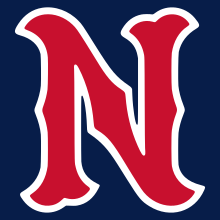
The Nashville Sounds are a Minor League Baseball team of the International League and the Triple-A affiliate of the Milwaukee Brewers. They are located in Nashville, Tennessee, and are named for the city's association with the music industry, specifically the "Nashville sound", a subgenre of country music which originated in the city in the mid-1950s. The team plays their home games at First Horizon Park, which opened in 2015 on the site of the historic Sulphur Dell ballpark. The Sounds previously played at Herschel Greer Stadium from its opening in 1978 until the end of the 2014 season. They are the oldest active professional sports franchise in Nashville.
Established as an expansion team of the Double-A Southern League in 1978, the Sounds led all of Minor League Baseball in attendance in their inaugural season and continued to draw the Southern League's largest crowds in each of their seven years as members. On the field, the team won six consecutive second-half division titles from 1979 to 1984 and won the Southern League championship twice: in 1979 as the Double-A affiliate of the Cincinnati Reds and again in 1982 as the Double-A affiliate of the New York Yankees. (Full article...) -
Image 14
Morris Berg (March 2, 1902 – May 29, 1972) was an American professional baseball catcher and coach in Major League Baseball who later served as a spy for the Office of Strategic Services during World War II. He played 15 seasons in the major leagues, almost entirely for four American League teams, though he was never more than an average player and was better known for being "the brainiest guy in baseball." Casey Stengel once described Berg as "the strangest man ever to play baseball."
Berg was a graduate of Princeton University and Columbia Law School, spoke several languages, and regularly read ten newspapers a day. His reputation as an intellectual was fueled by his successful appearances as a contestant on the radio quiz show Information Please, in which he answered questions about the etymology of words and names from Greek and Latin, historical events in Europe and the Far East, and ongoing international conferences. (Full article...) -
Image 15
Jack Roosevelt Robinson (January 31, 1919 – October 24, 1972) was an American professional baseball player who became the first African-American to play in Major League Baseball (MLB) in the modern era. Robinson broke the color line when he started at first base for the Brooklyn Dodgers on April 15, 1947. The Dodgers signing Robinson heralded the end of racial segregation in professional baseball, which had relegated black players to the Negro leagues since the 1880s.
Born in Cairo, Georgia, Robinson was raised in Pasadena, California. A four-sport student athlete at Pasadena Junior College and the University of California, Los Angeles, he was better known for football than he was for baseball, becoming a star college player with the UCLA Bruins football team. Following his college career, Robinson was drafted for service during World War II but was court-martialed for refusing to sit at the back of a segregated Army bus, eventually being honorably discharged. Afterwards, he signed with the Kansas City Monarchs of the Negro leagues, where he caught the eye of Branch Rickey, general manager of the Brooklyn Dodgers, who thought he would be the perfect candidate for breaking the color line in MLB. (Full article...)
General images - load new batch
-
Image 1Pick-off attempt on runner (in red) at first base (from Baseball rules)
-
Image 2The American Tobacco Company's line of baseball cards featured shortstop Honus Wagner of the Pittsburgh Pirates from 1909 to 1911. In 2007, the card shown here sold for $2.8 million. (from Baseball)
-
Image 3A New York Yankees batter (Andruw Jones) and a Boston Red Sox catcher at Fenway Park (from Baseball)
-
Image 5Pesäpallo, a Finnish variation of baseball, was invented by Lauri "Tahko" Pihkala in the 1920s, and after that, it has changed with the times and grown in popularity. Picture of Pesäpallo match in 1958 in Jyväskylä, Finland. (from Baseball)
-
Image 6A well-worn baseball (from Baseball)
-
Image 7In May 2010, the Philadelphia Phillies' Roy Halladay pitched the 20th major league perfect game. That October, he pitched only the second no-hitter in MLB postseason history. (from History of baseball)
-
Image 8Jackie Robinson in 1945, with the era's Kansas City Royals, a barnstorming squad associated with the Negro American League's Kansas City Monarchs (from History of baseball)
-
Image 9Diagram of a baseball field Diamond may refer to the square area defined by the four bases or to the entire playing field. The dimensions given are for professional and professional-style games. Children often play on smaller fields. (from Baseball)
-
Image 11Japanese-Americans spectating a World War II-era game while in an internment camp. America's ties to immigrants and to Japan have been deeply shaped by a shared baseball heritage. (from History of baseball)
-
Image 12Alexander Cartwright, father of modern baseball (from History of baseball)
-
Image 13Sadaharu Oh managing the Japan national team in the 2006 World Baseball Classic. Playing for the Central League's Yomiuri Giants (1959–80), Oh set the professional world record for home runs with 868. (from History of baseball)
-
Image 14Two players on the baseball team of Tokyo, Japan's Waseda University in 1921 (from Baseball)
-
Image 15An Afghan girl playing baseball in August 2002 (from Baseball)
-
Image 16Baseball games sometimes end in a walk-off home run, with the batting team usually gathering at home plate to celebrate the scoring of the winning run(s). (from Baseball rules)
-
Image 17Pitchers are generally substituted during mound visits (team gatherings at the pitcher's mound). (from Baseball rules)
-
Image 18Baserunners generally stand a short distance away from their base between pitches, preparing themselves to either go back or steal the next base. (from Baseball rules)
-
Image 19A game from the Cantigas de Santa Maria, c. 1280, involving tossing a ball, hitting it with a stick and competing with others to catch it (from History of baseball)
-
Image 20Sadaharu Oh managing the Japan national team in the 2006 World Baseball Classic. Playing for the Central League's Yomiuri Giants (1959–80), Oh set the professional world record for home runs. (from Baseball)
-
Image 22A first baseman receives a pickoff throw, as the runner dives back to first base. (from Baseball)
-
Image 23A batter follows through after swinging at a pitched ball. (from Baseball rules)
-
Image 24By the 1860s Civil War, baseball (bottom) had overtaken its fellow bat-and-ball sport cricket (top) in popularity within the United States. (from History of baseball)
-
Image 25Cover of Official Base Ball Rules, 1921 edition, used by the American League and National League (from Baseball rules)
-
Image 26The NL champion New York Giants baseball team, 1913. Fred Merkle, sixth in line, had committed a baserunning gaffe in a crucial 1908 game that became famous as Merkle's Boner. (from History of baseball)
-
Image 27Diagram indicating the standard layout of positions (from Baseball)
-
Image 31A pitcher handing off the ball after being taken out of the game during a mound meeting. (from Baseball)
-
Image 32Cy Young—the holder of many major league career marks, including wins and innings pitched, as well as losses—in 1908. MLB's annual awards for the best pitcher in each league are named for Young. (from Baseball)
-
Image 33The strike zone determines the result of most pitches, and varies in vertical length for each batter. (from Baseball)
-
Image 34The standard fielding positions (from Baseball rules)
-
Image 35Rickey Henderson—the major leagues' all-time leader in runs and stolen bases—stealing third base in a 1988 game (from Baseball)
-
Image 36Jackie Robinson in 1945, with the era's Kansas City Royals, a barnstorming squad associated with the Negro American League's Kansas City Monarchs (from Baseball)
-
Image 37The strike zone, which determines the outcome of most pitches, varies in vertical length depending on the batter's typical height while swinging. (from Baseball rules)
-
Image 382013 World Baseball Classic championship match between the Dominican Republic and Puerto Rico, March 20, 2013 (from Baseball)
-
Image 401906 World Series, infielders playing "in" for the expected bunt and the possible play at the plate with the bases loaded (from Baseball rules)
-
Image 41Fenway Park, home of the Boston Red Sox. The Green Monster is visible beyond the playing field on the left. (from Baseball)
-
Image 42A runner sliding into home plate and scoring. (from Baseball)
-
Image 45The typical motion of a right-handed pitcher (from Baseball rules)
 Good articles - load new batch
Good articles - load new batch
-
Image 1
Eric John Hosmer (born October 24, 1989) is an American former professional baseball first baseman. He played in Major League Baseball (MLB) for the Kansas City Royals, San Diego Padres, Boston Red Sox, and Chicago Cubs.
A highly touted prospect coming out of American Heritage High School in Florida, Hosmer was described as a "left-handed hitter with raw power" by scouts. The Royals selected him with third overall pick in the 2008 MLB draft, and he received a $6 million signing bonus. He advanced in Minor League Baseball before debuting in MLB during the 2011 season. He finished third in the Rookie of the Year balloting after the 2011 season after hitting .293 with 19 home runs in 128 games. Hosmer won consecutive Gold Glove Awards from 2013 through 2015 and again in 2017, when he also won the Silver Slugger Award. He was the MVP of the 2016 MLB All-Star Game, and was a member of the 2015 World Series champion Royals. (Full article...) -
Image 2
Clifton Phifer Lee (born August 30, 1978) is an American former professional baseball starting pitcher who played for 13 seasons in Major League Baseball (MLB). Between 2002 and 2014 he played for the Cleveland Indians, Philadelphia Phillies, Seattle Mariners, and Texas Rangers. During his career, Lee was a member of four All-Star teams, won the Cy Young Award, and had consecutive World Series appearances in 2009 and 2010 with the Phillies and Rangers.
Born and raised in Benton, Arkansas, Lee's 91 mph (146 km/h) fastball attracted the attention of MLB scouts during his senior year at Benton High School in 1997, but he rejected draft offers twice in order to play college baseball for Meridian Community College and later the Arkansas Razorbacks. Lee finally came to terms with the Expos after his selection in the fourth round of the 2000 MLB Draft, and he spent two years in their farm system before a trade to Cleveland in 2002. Lee made his MLB debut with his new team that year, and made his first opening day roster in 2004. His early years in Cleveland were marked by a number of temper flares, appearing to intentionally pitch at his opponents' heads and storming off of the mound, but by 2005, he was an established part of the Indians' starting rotation. The low point of his career, when he was sent back to the minor leagues in 2007, was followed by his Cy Young-winning season, during which he led the American League with a 2.54 earned run average and all of MLB with 22 wins. (Full article...) -
Image 3Leon Day (October 30, 1916 – March 13, 1995) was an American professional baseball pitcher who spent the majority of his career in the Negro leagues. Recognized as one of the most versatile athletes in the league during his prime, Day could play every position, with the exception of catcher, and often was the starting second baseman or center fielder when he was not on the mound. A right-handed pitcher with a trademark no wind-up delivery, Day excelled at striking batters out, especially with his high-speed fastball. At the same time, he was an above-average contact hitter, which, combined with his effectiveness as a baserunner and his tenacious fielding, helped cement Day as one of the most dynamic players of the era.
Debuting in the Negro leagues in 1934, Day played with the Baltimore Black Sox, Newark Eagles, and Baltimore Elite Giants during his career. In 1937, Day had the best season of his career as a member of the Eagles, finishing with a perfect record of 13–0 and a batting average over .300. Day also played Puerto Rican winter ball in the offseasons. He holds both the Negro and Puerto Rican league records for strikeouts in a game, and appeared in the most East–West All-Star Games. (Full article...) -
Image 4Taveras with the St. Louis Cardinals in 2014
Oscar Francisco Taveras (June 19, 1992 – October 26, 2014) was a Dominican–Canadian professional baseball outfielder who played one season for the St. Louis Cardinals of Major League Baseball (MLB). Known as "El Fenómeno" (Spanish for "The Phenomenon") in the Dominican Republic, the Cardinals signed him at age 16 in 2008 as an international amateur free agent and he made his MLB debut in 2014. Over six minor league seasons, he batted .321 with a .519 slugging percentage. He played all three outfield positions while spending most of the time in center field.
With prodigious batting skills, Taveras was a consensus top-five minor league prospect in 2013 and 2014. He elicited comparisons to former MLB outfielder and fellow Dominican Vladimir Guerrero—with a powerful and smooth, balanced stroke, Taveras successfully hit pitches well outside of the strike zone. Also similar to Guerrero, he possessed a strong and accurate throwing arm. The outfielder was the recipient of a litany of awards and won batting titles in two minor leagues, including hitting .386 for the Midwest League title in 2011. The next year, he won the Texas League batting title and was the Texas League Player of the Year and Cardinals organization Player of the Year. (Full article...) -
Image 5
Harold Patrick Kelly (July 30, 1944 – October 2, 2005) was an American professional baseball player who played in Major League Baseball (MLB) as an outfielder from 1967 to 1981 with the Minnesota Twins, Kansas City Royals, Chicago White Sox, Baltimore Orioles and the Cleveland Indians. He batted and threw left-handed. His brother, Leroy, was a Pro Football Hall of Fame running back.
Born and raised in Philadelphia, Pennsylvania, Kelly was an "All Public" baseball player at Simon Gratz High School, honored with the Cliveden Award as Philadelphia's finest prep school athlete in 1962. Signed by the Twins that year, he spent the next several seasons in the minor leagues, debuting with the Twins in 1967. He played a handful of games for them in 1968, then was selected in the 1968 Major League Baseball expansion draft by the Royals, becoming an everyday player over the next two years with the fledgling franchise. Traded to the White Sox before the 1971 season, he spent part of 1971 in the minor leagues but got more playing time as a right fielder and designated hitter in the following years, reaching the All-Star Game for the only time in his career in 1973. Traded to the Orioles after the 1976 season, he received significant playing time in left field in 1977 and 1978, then served as a bench player the next two years. With a career-high .536 slugging percentage in 1979, Kelly helped the Orioles reach the MLB playoffs, appearing in the World Series, which Baltimore lost to the Pittsburgh Pirates in seven games. After one last season with the Indians in 1981, Kelly retired. (Full article...) -
Image 6Matz with the New York Mets in 2019
Steven Jakob Matz (born May 29, 1991) is an American professional baseball pitcher for the St. Louis Cardinals of Major League Baseball (MLB). He has previously played in MLB for the New York Mets and Toronto Blue Jays. Matz was born and raised on Long Island and played baseball for Ward Melville High School in East Setauket, New York. The Mets drafted him directly out of high school in the second round of the 2009 MLB draft, with the 72nd overall selection.
The start of Matz's professional career was delayed two years due to Tommy John surgery needed for a tear in the ulnar collateral ligament of his throwing elbow. Matz made his professional debut in 2012 and spent three years in the Mets' minor leagues, helping lead the Savannah Sand Gnats and Binghamton Mets to championships. He was named the Mets' Organizational Pitcher of the Year in 2014. He made his MLB debut on June 28, 2015, breaking several hitting records in his first start. (Full article...) -
Image 7Statue of López in Tecamachalco, Puebla
Aurelio Alejandro López Rios (September 21, 1948 – September 22, 1992) was a Mexican professional baseball player. After pitching for several years in the Mexican League, he spent eleven seasons (1974, 1978–87) with four teams in Major League Baseball — a majority of it spent with the Detroit Tigers. He acquired the nickname "Señor Smoke" in Detroit, while he was known as "El Buitre de Tecamachalco" (The Vulture of Tecamachalco) in Mexico. López was discovered in his hometown by Mexican League scouts and converted from a starting pitcher to a relief pitcher.
López led the Mexico City Reds to the 1974 Mexican League World Series, then made a brief MLB debut with the Kansas City Royals before returning to the Mexican League. López was named the 1977 Mexican League Most Valuable Player (MVP). He returned to the major leagues with the St. Louis Cardinals in 1978 and pitched for the Detroit Tigers between 1979 and 1985. López finished seventh in the Cy Young Award voting in 1979. He earned a 10–1 record and 14 saves for Detroit's 1984 World Series championship team. (Full article...) -
Image 8
Benjamin José Molina (born July 20, 1974), nicknamed "Big Money", is a former Major League Baseball (MLB) catcher. He played for the Anaheim Angels / Los Angeles Angels of Anaheim (1998–2005), Toronto Blue Jays (2006), San Francisco Giants (2007–2010), and Texas Rangers (2010). He is the older brother of major league catchers José Molina and Yadier Molina.
Molina played a handful of games for the Anaheim Angels in 1998 and 1999. He became the Angels' regular catcher in 2000 and remained so through the 2005 season. In 2001, José became his teammate. Molina received his World Series ring in 2002 after the Angels defeated the Giants in the 2002 World Series. He won a Gold Glove in 2002 and 2003, leading American League (AL) catchers in percentage of attempted base stealers thrown out. (Full article...) -
Image 9
Curtis Granderson Jr. (born March 16, 1981), nicknamed "the Grandyman", is an American former professional baseball outfielder. He played 16 seasons in Major League Baseball (MLB) for the Detroit Tigers, New York Yankees, New York Mets, Los Angeles Dodgers, Toronto Blue Jays, Milwaukee Brewers, and Miami Marlins.
Granderson played college baseball at the University of Illinois at Chicago. He was selected by the Tigers in the 2002 MLB draft. He made his MLB debut with the Tigers in 2004. Granderson is a three-time MLB All-Star, and won a Silver Slugger Award in 2011. He retired after the 2019 season. (Full article...) -
Image 10
Samuel Timothy Coonrod (born September 22, 1992) is an American professional baseball pitcher who is a free agent. He has previously played in Major League Baseball (MLB) for the San Francisco Giants, Philadelphia Phillies, and New York Mets.
Coonrod was born in St. Louis, Missouri, and raised in Carrollton, Illinois. He played high school baseball at Carrollton High School, where he helped his team win a state championship his senior season and became the first player in school history to have his jersey number retired. After high school, Coonrod spent three years playing college baseball with the Southern Illinois Salukis of the Missouri Valley Conference. He also played for two collegiate summer baseball teams: the Quincy Gems in 2012 and the Yarmouth-Dennis Red Sox in 2013. (Full article...) -
Image 11
Ian Patrick Kennedy (born December 19, 1984) is an American former professional baseball pitcher. Between 2007 and 2023, he played 17 seasons in Major League Baseball (MLB) for the New York Yankees, Arizona Diamondbacks, San Diego Padres, Kansas City Royals, Texas Rangers, and Philadelphia Phillies.
A standout pitcher at La Quinta High School in California, Kennedy played three seasons of college baseball for the USC Trojans. The Yankees selected him 21st overall in the 2006 MLB Draft and he quickly rose through the team's farm system, making his major league debut the next year. The Yankees traded Kennedy to the Diamondbacks after the 2009 season, and he became Arizona's ace, leading the National League in wins during the 2011 season. (Full article...) -
Image 12
Logan O'Hoppe (/oʊˈhɒpiː/ oh-HOP-ee; born February 9, 2000) is an American professional baseball catcher for the Los Angeles Angels of Major League Baseball (MLB).
O'Hoppe was born in West Islip, New York and attended St. John the Baptist Diocesan High School, committing to play college baseball for East Carolina University. He forewent his college commitment when he was drafted by the Philadelphia Phillies in the 23rd round of the 2018 Major League Baseball draft. O'Hoppe spent his first five professional seasons in the Phillies farm system, garnering media consideration as one of the team's top prospects. In August 2022, O'Hoppe was traded to the Angels at the trade deadline and he made his major league debut the next month. (Full article...) -
Image 13
Ross Middlebrook "Pep" Youngs (April 10, 1897 – October 22, 1927) was an American professional baseball player. Nicknamed "Pep", he played ten seasons in Major League Baseball for the New York Giants from 1917 through 1926, playing right field almost exclusively. Youngs was a part of the Giants teams that won four consecutive National League pennants and the 1921 and 1922 World Series.
From Shiner, Texas, Youngs excelled at baseball and American football at the West Texas Military Institute. After beginning his professional career in minor league baseball, Youngs was signed by the Giants in 1916. Youngs had a lifetime .322 batting average with the Giants and batted over .300 nine times in his career, including eight consecutive seasons. His career was cut short by illness, however, as he died at the age of 30 of Bright's disease. (Full article...) -
Image 14Francisco "Pancho" Coimbre Atiles (29 January 1909 – 4 November 1989), more commonly known as Pancho Coimbre, was a Puerto Rican professional baseball player. He was born in the municipality of Coamo and moved to Ponce early in his life. It was in Ponce where he would begin to actively participate in sports, both in sprinting and baseball. Coimbre played thirteen seasons in the Puerto Rican Professional Baseball League (LBPPR), with the Leones de Ponce. During this period the team won five league championships. He finished his career with an average of .337, and had an average of 2.2 strikeouts per season, this included four consecutive seasons from 1939 to 1942, without any strikeouts. Coimbre also won two LBPPR batting titles and the league's Most Valuable Player Award in 1943.
Coimbre traveled to New York City, after completing his first professional season in Puerto Rico, where he joined the Porto Rico Stars baseball team of the Negro leagues.[A] He was contracted by the New York Cubans while playing with the Porto Rico Stars. He joined the NY Cubans and played several seasons for them. Coimbre's batting average remained over the .300 mark, including two seasons in which he batted over .400. While playing in the Negro leagues he was selected to play in the league's East–West All-Star games twice, where he played with several players who in the future would be elected to the Baseball Hall of Fame and Museum. He also played with teams established in Colombia, Venezuela, the Dominican Republic and Mexico. Following his retirement, Coimbre worked as a coach and manager of teams in both the professional and amateur leagues of Puerto Rico. Coimbre, who was eighty years old, died due to a fire at his home. (Full article...) -
Image 15
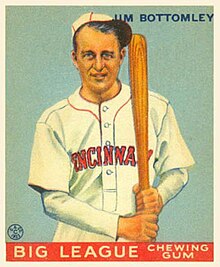
James Leroy Bottomley (April 23, 1900 – December 11, 1959) was an American professional baseball first baseman, scout and manager. He played in Major League Baseball (MLB) as a first baseman from 1922 to 1937, most prominently as a member of the St. Louis Cardinals where he helped lead the team to four National League pennants and two World Series titles.
Born in Oglesby, Illinois, Bottomley grew up in Nokomis, Illinois. He dropped out of high school at the age of 16 to raise money for his family. While he was playing semi-professional baseball, the Cardinals scouted and signed Bottomley before the 1920 season. He became an integral member of the Cardinals batting order, driving in 100 or more runs batted in between 1924 and 1929 as the team's cleanup hitter. In 1924, he established a major league record for driving in 12 runs in a nine inning game. (Full article...)
Did you know (auto-generated) - load new batch

- ... that Devin Futrell used a post to dodge a draft?
- ... that baseball player Nick Solak was named after the sports bar where his parents first met?
- ... that Margaret Donahue was the first female executive in Major League Baseball?
- ... that Larry Kennedy played professional baseball while serving as his town's mayor?
- ... that Salty Parker, who spent 60 years in organized baseball, described his lifelong love of the game as "a beautiful disease"?
- ... that baseball player Shane Rawley has published a novel?
- ... that baseball player Joey Marciano is a cousin of world heavyweight champion Rocky Marciano?
- ... that Dr. Twink Twining was a Major League Baseball player?
Quotes
| "Baseball has been good to me since I quit trying to play it." |
 Featured lists - load new batch
Featured lists - load new batch
-
Image 1

Roy Oswalt, the Houston Astros Opening Day starting pitcher for eight straight years, from 2003 through 2010.
The Houston Astros are a Major League Baseball (MLB) franchise based in Houston, Texas. They currently play in the American League West division. The first game of the new baseball season for a team is played on Opening Day, and being named the Opening Day starter is an honor, which is often given to the player who is expected to lead the pitching staff that season, though there are various strategic reasons why a team's best pitcher might not start on Opening Day.
The Astros began to play in 1962 as the Houston Colt .45s (their name was changed to the Astros in 1965 when the Houston Astrodome opened as their home ball park). Bobby Shantz started their first Opening Day game on April 10, 1962, against the Chicago Cubs at Houston's Colt Stadium and was credited with the win. In their first eight seasons, the Colt .45s / Astros used eight different Opening Day starters. In 1970, that streak ended when Larry Dierker made his second Opening Day start. (Full article...) -
Image 2

Don Larsen threw the only perfect game ever in MLB postseason play.
The New York Yankees are a Major League Baseball franchise based in the New York City borough of The Bronx. Also known in their early years as the "Baltimore Orioles" (1901–02) and the "New York Highlanders" (1903–1912), the Yankees have had twelve pitchers throw thirteen no-hitters in franchise history. A no-hitter is officially recognized by Major League Baseball only "...when a pitcher (or pitchers) allows no hits during the entire course of a game, which consists of at least nine innings. In a no-hit game, a batter may reach base via a walk, an error, a hit by pitch, a passed ball or wild pitch on strike three, or catcher's interference". No-hitters of fewer than nine complete innings were previously recognized by the league as official; however, several rule alterations in 1991 changed the rule to its current form. Four perfect games, a special subcategory of no-hitter, have been pitched in Yankees history. As defined by Major League Baseball, "in a perfect game, no batter reaches any base during the course of the game." This feat was achieved by Don Larsen in 1956, David Wells in 1998, David Cone in 1999, and Domingo German in 2023. Wells later claimed he was a "little hung-over" while throwing his perfect game.
George Mogridge threw the first no-hitter in Yankees history, beating their rival Boston Red Sox 2–1, their only no-hitter in which the opposition scored. Their most recent no-hitter was Domingo Germán's perfect game against the Oakland Athletics during the 2023 season on June 28. The Yankees' first perfect game was also thrown by a right-handed pitcher, Don Larsen, and came in Game 5 of the 1956 World Series. Larsen's perfect game was the only no-hitter in MLB postseason play until Roy Halladay of the Philadelphia Phillies pitched a no-hitter in Game 1 of the 2010 National League Division Series. Coincidentally, David Cone's perfect game came on "Yogi Berra Day" at Yankee Stadium. Berra had caught Larsen's perfect game and both he and Larsen were in the stands for the game. Of the twelve no-hitters pitched by Yankees players, three each have been won by the scores 4–0 and 2–0, more common than any other result. The largest margin of victory in a Yankees no-hitter was 13 runs in a 13–0 win by Monte Pearson. German's perfect game represented the second largest margin of victory in a Yankees no-hitter, as the Yankees defeated the Athletics 11–0 in the 24th perfect game in MLB history. (Full article...) -
Image 3
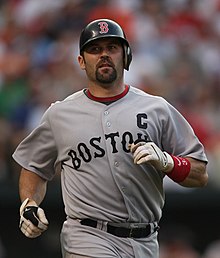
Jason Varitek, who has caught a record four no-hitters, was a selected by the American Baseball Coaches Association, Baseball America, and Collegiate Baseball.
An All-American team is an honorary sports team composed of the best amateur players of a specific season for each position—who in turn are given the honorific "All-America" and typically referred to as "All-American athletes", or simply "All-Americans". Although the honorees generally do not compete as a unit, the term is used in United States team sports to refer to players who are selected by members of the national media. Walter Camp selected the first All-America team in the early days of American football in 1889. In 1950, the American Baseball Coaches Association (ABCA) selected its first All-American baseball team. It has since chosen All-American teams and a player of the year for each division (National Collegiate Athletic Association (NCAA) Division I, Division II, Division III, National Association of Intercollegiate Athletics, junior college and high school). Collegiate Baseball selects All-American, Freshman All-American and High School All-American teams. Baseball America selects pre-season and post-season All-American teams and College Player of the Year honorees.
Various organizations selected All-American lists of the best players for the 1992 NCAA Division I college baseball season. The ABCA, the magazine Baseball America, and Collegiate Baseball were the NCAA-sanctioned selectors. This list only includes players selected to the post-season All-American first team for each selector. However, many All-American selections choose second, third, etc. teams from the remaining eligible candidates. (Full article...) -
Image 4

Hard Rock Stadium, the Marlins former home ballpark from 1993-2011
The Miami Marlins are a Major League Baseball (MLB) franchise based in Miami, Florida. They play in the National League East division. The first game of the new baseball season for a team is played on Opening Day, and being named the Opening Day starter is an honor, which is often given to the player who is expected to lead the pitching staff that season, though there are various strategic reasons why a team's best pitcher might not start on Opening Day. The Marlins have used 17 different Opening Day starting pitchers in their 27 seasons. Since the Marlins' first season in 1993, the 17 starters have a combined Opening Day record of 12 wins and 14 losses with two no-decisions. Notably, no Marlins Opening Day starter received a no-decision until the team's 24th season in 2016. No-decisions are only awarded to the starting pitcher if the game is won or lost after the starting pitcher has left the game.
Nine Marlins pitchers have started on two or more Opening Days. Those nine are Charlie Hough, Kevin Brown, Alex Fernandez, Ryan Dempster, Josh Beckett, Dontrelle Willis, Josh Johnson, Ricky Nolasco, and José Ureña. Beckett and Johnson hold the record for most Opening Day starts as a Marlin, with three appearances each, from 2003 to 2005 for Beckett and 2010 to 2012 for Johnson. When playing at their original home field, the venue now known as Hard Rock Stadium, the Marlins had a record of nine wins and five losses (9–5). At their current home of Marlins Park, Opening Day pitchers have a record of 1–5 with one no-decision. In the franchise's history, the Marlins have only played Opening Day games at another team's home stadium eight times. As the away team, Marlins' starting pitchers have an Opening Day record of 1–6 with one no-decision. (Full article...) -
Image 5
The Edgar Martínez Outstanding Designated Hitter Award, commonly referred to as the Edgar Martínez Award and originally known as the Outstanding Designated Hitter Award, has been presented annually to the most outstanding designated hitter (DH) in Major League Baseball (MLB) since 1973. The award is voted on by club beat reporters, broadcasters, and public relations departments. The Associated Press discontinued the award in 2000, but it was picked up by the Baseball Writers' Association of America, which has administered it since. All players with a minimum of 100 at bats at DH are eligible. From the award's inception in 1973 until 2019, and in 2021, use of the designated hitter was allowed only in the American League (AL).
In September 2004, at Safeco Field (now T-Mobile Park) ceremonies in honor of Edgar Martínez, Commissioner Bud Selig announced that the award would be renamed for the five-time recipient (1995, 1997–98, 2000–01). In an 18-year career with the Seattle Mariners, primarily as a designated hitter, Martínez batted .312, with 309 career home runs and 1,261 runs batted in. (Full article...) -
Image 6The San Diego Padres are an American professional baseball team based in San Diego. The Padres compete in Major League Baseball (MLB) as a member club of the National League (NL) West Division. The team joined MLB in 1969 as an expansion team and have won two NL Championships, in 1984 and 1998. The team played their home games at San Diego Stadium from 1969 to 2003. Starting with the 2004 season, they moved to Petco Park, where they have played since. The team is owned by the estate of Peter Seidler, and A. J. Preller is their general manager. There have been 21 managers for the Padres franchise. The team is currently managed by Mike Shildt.
The first manager of the Padres was Preston Gómez, who managed for four seasons. Bruce Bochy is the franchise's all-time leader for the most regular-season games managed (1926), the most regular-season game wins (951), the most playoff games managed (24), and the most playoff-game wins (8). Bob Skinner is the Padres' all-time leader for the highest regular-season winning percentage, as he has only managed one game, which he won. Of the managers who have managed a minimum of 162 games (one season), Jack McKeon has the highest regular-season winning percentage with .541, having managed for 357 games. Dick Williams, the only Padres manager to have been elected into the Baseball Hall of Fame, is the franchise's all-time leader for the highest playoff winning percentage with .400. Williams and Bochy are the only managers to have won an NL Championship with the Padres, in 1984 and 1998 respectively. Bochy and Black are the only managers to have won a Manager of the Year Award with the Padres, in 1996 and 2010. Greg Riddoch and Jerry Coleman have spent their entire managing careers with the Padres. (Full article...) -
Image 7

Hank Aaron, the holder of ten franchise records for the Braves
The Atlanta Braves are a Major League Baseball (MLB) franchise based in Atlanta. The Braves formed in 1871 as the Boston Red Stockings. After moving in 1953 to Milwaukee for 12 years and a World Series Championship in '57, the Braves relocated to Atlanta in 1966. Through 2010, the Braves have played 20,053 games, winning 9,945, losing 9,954, and tying 154, for a winning percentage of approximately .500. This list documents the superlative records and accomplishments of team members during their tenures in MLB.
Hank Aaron holds the most franchise records as of the end of the 2010 season, with ten, including most career hits, doubles, and the best career on-base plus slugging percentage. Aaron also held the career home runs record from April 8, 1974 until August 8, 2007. He is followed by Hugh Duffy, who holds eight records, including best single-season batting average and the best single-season slugging percentage record. (Full article...) -
Image 8
The All-Star Final Vote was an annual Internet and text message ballot by Major League Baseball (MLB) fans to elect the final player for each team that participates in the Major League Baseball All-Star Game, after all other selections were made and announced. The first 33 players were selected by a combination of procedures. The sponsorship changed annually, but the contest remained similar from year to year. Each league presented a five-man ballot and gave the fans a few days to choose one final All-Star. This process was used from 2002 through 2018. (Full article...) -
Image 9
The Chicago White Sox celebrate after defeating the Minnesota Twins 1–0 to win the 2008 American League Central.
A tie-breaker was required in Major League Baseball (MLB) when two or more teams were tied at the end of the regular season for a postseason position such as a league pennant (prior to the introduction of the League Championship Series in 1969), a division title, or a wild card spot. Until 2022, both the American League (AL) and the National League (NL) used a one-game playoff format for tie-breakers, although the NL used a best-of-three series prior to 1969, when the leagues were split into divisions. As these tie-breaker games counted as part of the regular season and MLB teams (American League beginning in 1961, and National League beginning in 1962) have 162-game regular season schedules, the tie-breaker games were sometimes referred to as "Game 163". In 2022, as part of the new Collective Bargaining Agreement to end the 2021–22 Major League Baseball lockout, tiebreaker games were replaced with statistical tiebreaker procedures.
Sixteen tie-breakers – 12 single-game and four series – have been played in MLB history. In baseball statistics, tie-breaker games counted as regular season games with all events in them counted towards regular season statistics. This had implications on statistical races, such as when Matt Holliday won the batting average and runs batted in titles thanks in part to his performance in the 2007 tie-breaker. Home-field advantage for tie-breakers was determined by a coin flip through the 2008 season, after which performance-based criteria, starting with head-to-head record of the tied teams, were put in place. (Full article...) -
Image 10

Jewish players have played in Major League Baseball since the league came into existence in the late 19th century, and have a long and storied history within the game. There have been 190 players who identified as Jewish during their Major League career, including players who converted during or before their careers, and players who have or had at least one Jewish parent, and identified as Jewish by virtue of their parentage.
In the early years, Jewish baseball players faced constant antisemitic heckles from opponents and fans, with many hiding their heritage to avoid discrimination in the league. Despite this, a number of Jewish players overcame such abuse and went on to become stars. Two such players, Hank Greenberg and Sandy Koufax, were both elected to the Baseball Hall of Fame and are widely considered to be amongst the most important and iconic players in baseball and American history. The sport played a large part in the assimilation of American Jews into American society at a time of rampant antisemitism, and remains a very important part in Jewish American culture today. (Full article...) -
Image 11

The Nashville Sounds ownership group consisted of 15 shareholders in their inaugural 1978 season. (Top row, from left: Bob Elliott, Billy Griggs, Jimmy Miller, Walter Nipper, Farrell Owens; Middle row: Jerry Reed, Larry Schmittou, Cal Smith, Gene Smith, Marcella Smith; Bottom row: Reese Smith Jr., Reese Smith III, Steven Smith, Conway Twitty, and L. E. White)
The Nashville Sounds Minor League Baseball team has played in Nashville, Tennessee, since being established in 1978 as an expansion team of the Double-A Southern League. They moved up to Triple-A in 1985 as members of the American Association before joining the Pacific Coast League in 1998. They were placed in the Triple-A East in 2021, but this became the International League in 2022. The Sounds were originally owned by a local group, headed by Larry Schmittou, which included baseball figures, country musicians, and businessmen. Shares in the team have subsequently changed hands multiple times. Since 2009, the Sounds have been owned by MFP Baseball, composed of real estate investors Masahiro Honzawa and Frank Ward.
In the franchise's history, 15 general managers (GMs) have been employed to oversee day-to-day operations. Among the responsibilities of the general manager are overseeing ticket and advertising sales, developing corporate relationships, managing front office and game-day staff, and maintaining the team's player development license with their Major League Baseball affiliate. The longest-tenured general manager is Larry Schmittou with 13 years of service to the team in that role from 1980 to 1982 and 1987 to 1996. Adam English has been the Sounds' GM since October 2021. (Full article...) -
Image 12The Dick Howser Trophy is bestowed annually to the national college baseball player of the year. The award is named after former collegiate and Major League Baseball (MLB) player and manager Dick Howser, who died as the result of brain cancer on June 17, 1987, at the age of 51. In that same year, the award was established by friends of Howser and presented to Mike Fiore, the inaugural winner. It is considered to be the Heisman Trophy of college baseball.
Six winners of the Dick Howser Trophy are members of the National College Baseball Hall of Fame. Five winners—Kris Benson, David Price, Stephen Strasburg, Adley Rutschman, and Paul Skenes—went on to become the first overall MLB draft pick. Jason Jennings, Buster Posey, and Kris Bryant went on to win the Rookie of the Year Award several years after winning the Dick Howser Trophy. Jered Weaver is the only award winner to pitch a no-hitter, while Mark Teixeira holds the record for most games with home runs from both sides of the plate. Furthermore, seventeen players won the Golden Spikes Award alongside the Dick Howser Trophy. Brooks Kieschnick is the only player to win the trophy more than once. (Full article...) -
Image 13

Ryne Sandberg has the most wins among National League second basemen with seven Silver Slugger Awards.
The Silver Slugger Award is awarded annually to the best offensive player at each position in both the American League (AL) and the National League (NL), as determined by the coaches and managers of Major League Baseball (MLB). These voters consider several offensive categories in selecting the winners, including batting average, slugging percentage, and on-base percentage, in addition to "coaches' and managers' general impressions of a player's overall offensive value". Managers and coaches are not permitted to vote for players on their own team. The Silver Slugger was first awarded in 1980 and is given by Hillerich & Bradsby, the manufacturer of Louisville Slugger bats. The award is a bat-shaped trophy, 3 feet (91 cm) tall, engraved with the names of each of the winners from the league and plated with sterling silver.
Among second basemen, Ryne Sandberg, who played 15 seasons with the Chicago Cubs in his 16-year career, is tied for the most Silver Sluggers all-time with seven wins, and is first among all National League second basemen, including five consecutive from 1988 to 1992. Three other National League players have won the award four times. Jeff Kent (2000–2002, 2005) won three consecutive awards with the San Francisco Giants, before adding a fourth with the Los Angeles Dodgers; Craig Biggio, who played his entire career with the Houston Astros, won the award four times as a second baseman (1994–1995, 1997–1998) after winning another as a catcher. Chase Utley followed Kent's last win by capturing four consecutive awards (2006–2009). (Full article...) -
Image 14In baseball, a player earns a Triple Crown when he leads a league in three specific statistical categories in the same season. The term "Triple Crown" generally refers to the batting achievement of leading a league in batting average, home runs, and runs batted in (RBI) over the same season. The term "Pitching Triple Crown" refers to the pitching achievement of leading a league in wins, strikeouts, and earned run average (ERA).
The term "Triple Crown" is typically used when a player leads one league, such as the American League (AL) or the National League (NL), in the specified categories. A tie for a lead in any category, such as home runs, is sufficient to be considered the leader in that category. A "Major League Triple Crown" may be said to occur when a player leads all of Major League Baseball in all three categories. (Full article...) -
Image 15

Barry Zito was the San Francisco Giants' Opening Day starting pitcher in 2007 and 2008.
The San Francisco Giants are a Major League Baseball franchise based in San Francisco, California. They moved to San Francisco from New York City in 1958. They play in the National League West division. The first game of the new baseball season for a team is played on Opening Day, and being named the Opening Day starter is an honor, which is often given to the player who is expected to lead the pitching staff that season, though there are various strategic reasons why a team's best pitcher might not start on Opening Day. Through 2016, the Giants have used 30 different Opening Day starting pitchers in their 58 seasons since moving to San Francisco. The 30 starters have a combined Opening Day record of 27 wins, 16 losses and 16 no decisions. No decisions are only awarded to the starting pitcher if the game is won or lost after the starting pitcher has left the game.
The first Opening Day game for the San Francisco Giants was played against the Los Angeles Dodgers on April 15, 1958, at Seals Stadium, the Giants' first home ball park in San Francisco. Rubén Gómez was the Giants' Opening Day starting pitcher that day, in a game the Giants lost 8–0. That was the Giants' only Opening Day game at Seals Stadium. They also played in two other home parks in San Francisco: Candlestick Park from 1960 to 1999, and Oracle Park, previously called PacBell Park, SBC Park and AT&T Park, since 2000. The Giants' Opening Day starting pitchers had a record of seven wins, three losses and seven no decisions at Candlestick Park and have a record of two wins, one loss and one no decision at AT&T Park. That gives the San Francisco Giants' Opening Day starting pitchers a total home record of 10 wins, 4 losses and 8 no decisions. Their record in Opening Day road games is 17 wins, 12 losses, and 8 no decisions. (Full article...)
More did you know
- ... that Elmer Stricklett is considered to have been the first baseball pitcher to master the spitball?
- ... that the Curse of Billy Penn is an alleged curse that may explain the failures of Philadelphia professional sports teams?
- ... that Chick Gandil was the ringleader of the 1919 Black Sox Scandal in American baseball?
- ... that Buzzie Bavasi was the general manager of the Brooklyn & Los Angeles Dodgers for eighteen years, helping the team win their first four World Series championships?
- ... that Hall of Fame manager Miller Huggins executed the first delayed steal in recorded baseball history?
Sports portals
Selected picture
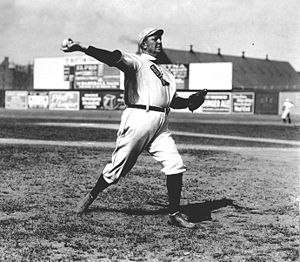
| Credit: George Grantham Bain |
Denton True "Cy" Young (March 29, 1867 – November 4, 1955) was an American baseball player who pitched for five different major league teams from 1890 to 1911. During his 22-year career, Young established numerous professional pitching records in the majors, some of which have stood for a century. Young retired with 511 career wins, 94 wins ahead of Walter Johnson, who is second on the list of most wins in Major League history. In honor of Young's contributions to Major League Baseball (MLB), the Cy Young Award, an annual award given to the pitcher voted the most effective in each of the two leagues, was created in 1956. Young was also elected to the Baseball Hall of Fame in 1937.
Associated Wikimedia
The following Wikimedia Foundation sister projects provide more on this subject:
-
Commons
Free media repository -
Wikibooks
Free textbooks and manuals -
Wikidata
Free knowledge base -
Wikinews
Free-content news -
Wikiquote
Collection of quotations -
Wikisource
Free-content library -
Wikiversity
Free learning tools -
Wiktionary
Dictionary and thesaurus
More portals
- Portals with triaged subpages from June 2018
- All portals with triaged subpages
- Portals with no named maintainer
- Automated article-slideshow portals with 51–100 articles in article list
- Automated article-slideshow portals with 501–1000 articles in article list
- Random portal component with 41–50 available subpages
- Automated article-slideshow portals with 201–500 articles in article list
- Random portal component with 11–15 available subpages
- Random portal component with 21–25 available image subpages

